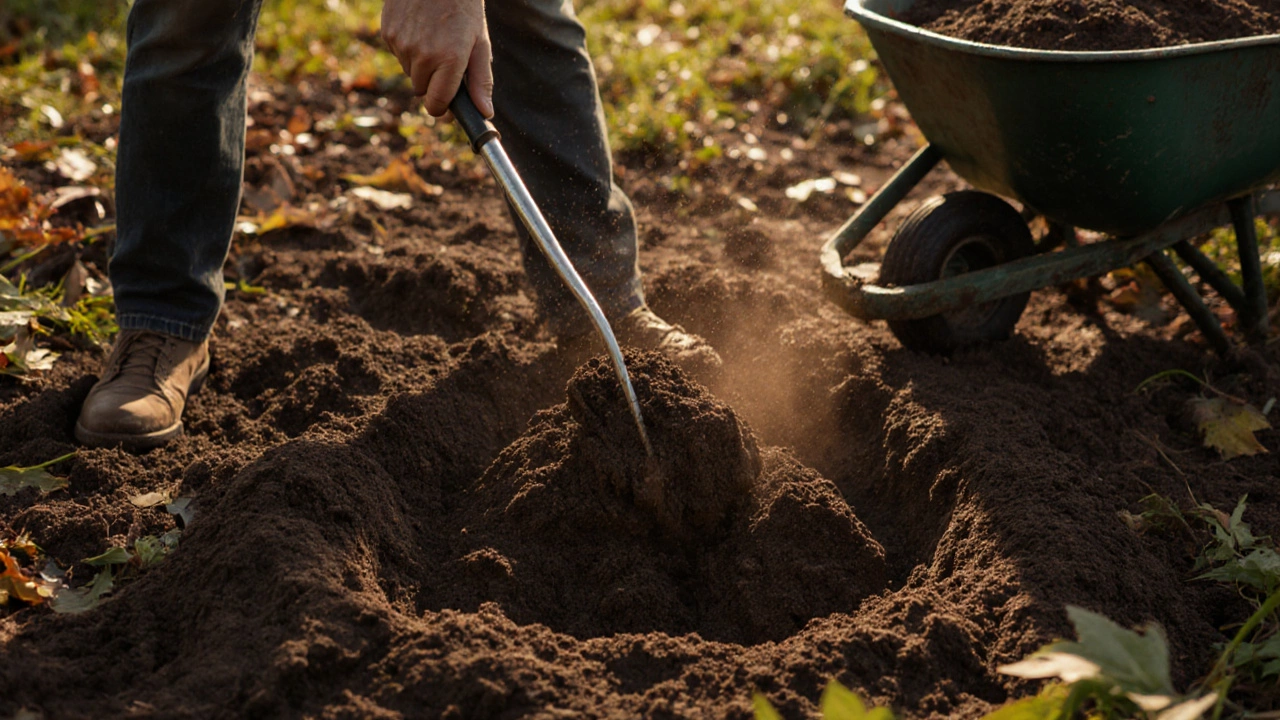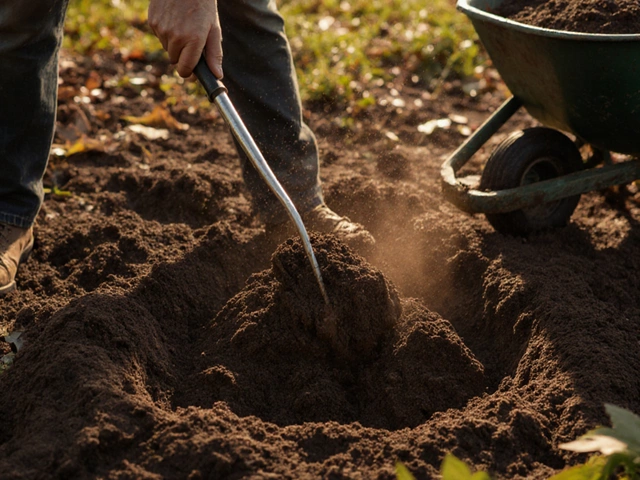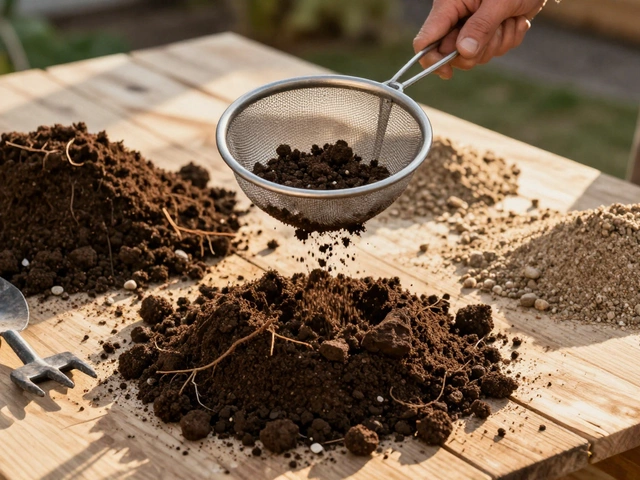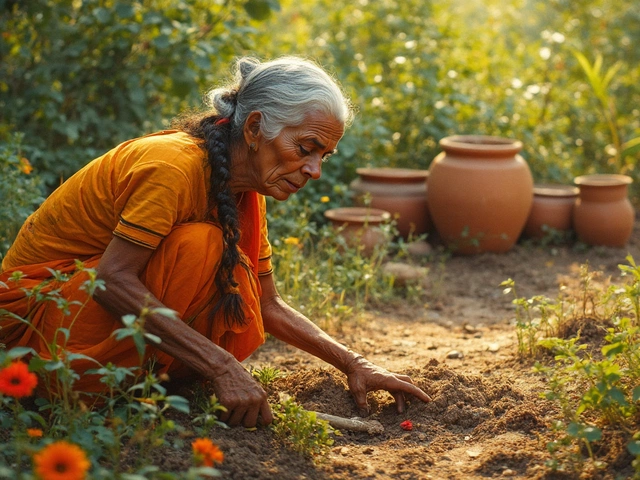Soil Amendment Calculator
Custom Soil Improvement Plan
Calculate your specific amendment needs based on soil type and garden size
Clay
Dense, sticky, slow-draining
Sandy
Fast-draining, loose
Loamy
Ideal balance
If your garden soil feels like concrete after a light rain, or if your seedlings refuse to push through the surface, you’re not alone. Dense, heavy soil - especially clay - is a common problem in places like Brighton, where the ground holds water and compacts easily. The good news? You don’t need to dig it all up and start over. You just need to add the right things to break it up, let air in, and give roots room to breathe.
Why Dense Soil Is a Problem
Dense soil doesn’t just make digging hard. It suffocates plants. Roots need oxygen, water, and space to spread. When soil is packed tight, water pools on top instead of soaking in. Fertilizers sit on the surface instead of reaching roots. Earthworms and beneficial microbes can’t move through it. Over time, your plants get stressed, yellow, or just die back.
Clay soil is the usual culprit. It’s made of tiny, flat particles that stick together like wet wallpaper paste. Sandy soil drains too fast. Loamy soil - the ideal mix - is rare in urban gardens. Most people end up with something in between, and that’s where amendments come in.
Top 5 Things to Add to Loosen Dense Soil
Not all soil amendments are created equal. Some give quick results. Others build long-term health. Here’s what actually works, based on years of testing in UK gardens.
1. Compost - The Gold Standard
Homemade compost is the single most effective thing you can add. It’s not just fertilizer - it’s a soil conditioner. Compost opens up clay particles, creates air pockets, and feeds microbes that naturally break down compacted layers.
Use well-rotted compost, not fresh manure or unfinished piles. Spread a 2- to 3-inch layer over your garden bed and mix it into the top 6 to 8 inches of soil. Do this in early spring or fall, when the ground isn’t frozen or waterlogged.
Don’t just buy bagged compost from the garden center. Many are just finely ground bark or peat, which doesn’t help structure. Look for compost labeled “plant-based” or “vermicompost.” If you can’t make your own, ask neighbors who compost - they often have extra.
2. Perlite - The Lightweight Breaker
Perlite is a volcanic rock that’s been heated until it pops like popcorn. It’s white, lightweight, and doesn’t break down. It’s perfect for cutting through clay.
Unlike sand (which can make clay even denser when mixed in small amounts), perlite holds air and water without collapsing. Add 1 part perlite to 3 parts soil. Mix it in thoroughly. You’ll notice the soil feels fluffier right away.
It’s especially useful in raised beds and container gardens. A 50/50 mix of compost and perlite is a winning combo for vegetable rows or flower borders.
3. Grit Sand - The Right Kind of Sand
Not all sand is good. Play sand or builder’s sand can glue clay particles together and make things worse. But coarse, sharp grit sand - the kind used in concrete or for drainage - is different.
Use horticultural grit or sharp sand (look for the words “angular particles” on the bag). It has rough edges that physically separate clay particles. Add 1 bucket per square meter and mix it into the top 15 cm. It’s slower acting than perlite but lasts longer.
Best for: Large beds, pathways, or areas where you want permanent improvement. Avoid if you’re on a tight budget - it’s heavier and more expensive than compost.
4. Leaf Mold - Nature’s Soil Softener
Leaf mold is just decomposed leaves. It’s easy to make: pile up autumn leaves in a wire bin, keep them damp, and wait a year. By next fall, you’ll have dark, crumbly soil that smells like a forest floor.
Leaf mold improves water retention in sandy soil and breaks up clay without adding nutrients - which is actually good. Too many nutrients in dense soil can cause algae blooms or lock up minerals. Leaf mold just makes the texture better.
Spread it as a mulch in winter. Rain and worms will pull it down naturally. Or mix it in with compost in spring. It’s free, sustainable, and perfect for UK gardens.
5. Coconut Coir - The Sustainable Alternative to Peat
Peat moss used to be the go-to for loosening soil. But peat bogs are disappearing fast. Coconut coir - made from shredded coconut husks - is a better choice. It holds water well, resists compaction, and is renewable.
Use it in dry form or as compressed bricks you soak in water. Mix 1 part coir with 2 parts soil. It’s especially useful in containers or when you’re starting new beds.
Coir doesn’t add nutrients, so pair it with compost. It’s pricier than leaf mold but lasts longer and doesn’t blow away in wind.
What NOT to Add
Some common fixes make things worse.
- Don’t add clay soil - obvious, but people do it by accident when they bring in topsoil from elsewhere.
- Don’t use only sand - fine sand + clay = concrete. Only use coarse grit.
- Don’t till too deep - turning soil over and over destroys its natural structure. Mix amendments only into the top 8-12 inches.
- Don’t rely on chemical “soil looseners” - most are marketing gimmicks. They don’t fix the root problem: lack of organic matter.
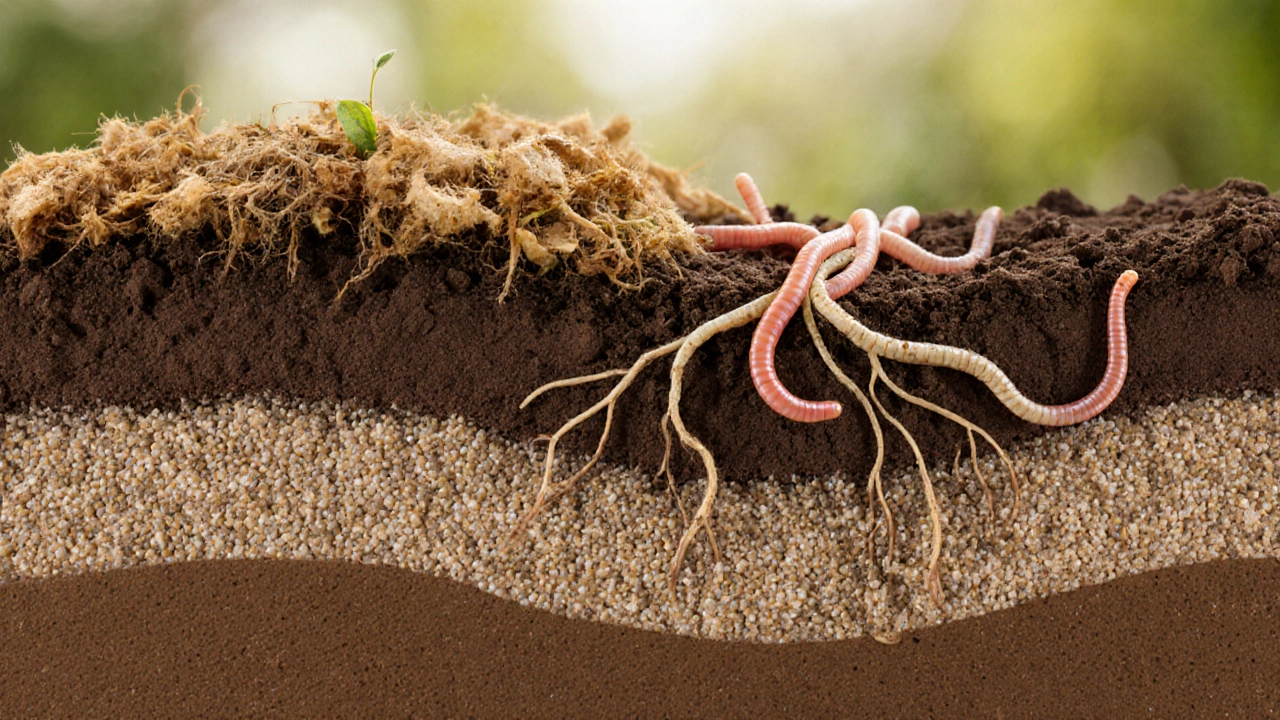
How to Apply Amendments Correctly
Adding stuff isn’t enough. You have to mix it in right.
- Wait for dry soil. Working wet clay turns it into glue.
- Clear weeds and debris.
- Spread your chosen amendment evenly over the surface.
- Use a garden fork - not a spade - to gently lift and turn the soil. Forks break clumps without crushing structure.
- Work in sections. Don’t try to do the whole garden at once.
- Water lightly after mixing to help settle everything.
Repeat this process every year for the first 3 years. After that, just top-dress with compost in spring. The soil will keep improving.
How Long Does It Take to See Results?
Don’t expect miracles overnight. Soil improvement is a slow game.
- 1-3 months: You’ll notice water soaks in faster. The soil feels less sticky when you squeeze it.
- 6-12 months: Roots grow deeper. Plants look healthier. Earthworms return.
- 2-3 years: Your soil becomes workable, crumbly, and rich - the kind you can dig with your hands.
Some people try to rush it with power tillers. That breaks down soil structure even more. Patience pays. The best gardens aren’t built in a weekend - they’re grown over seasons.
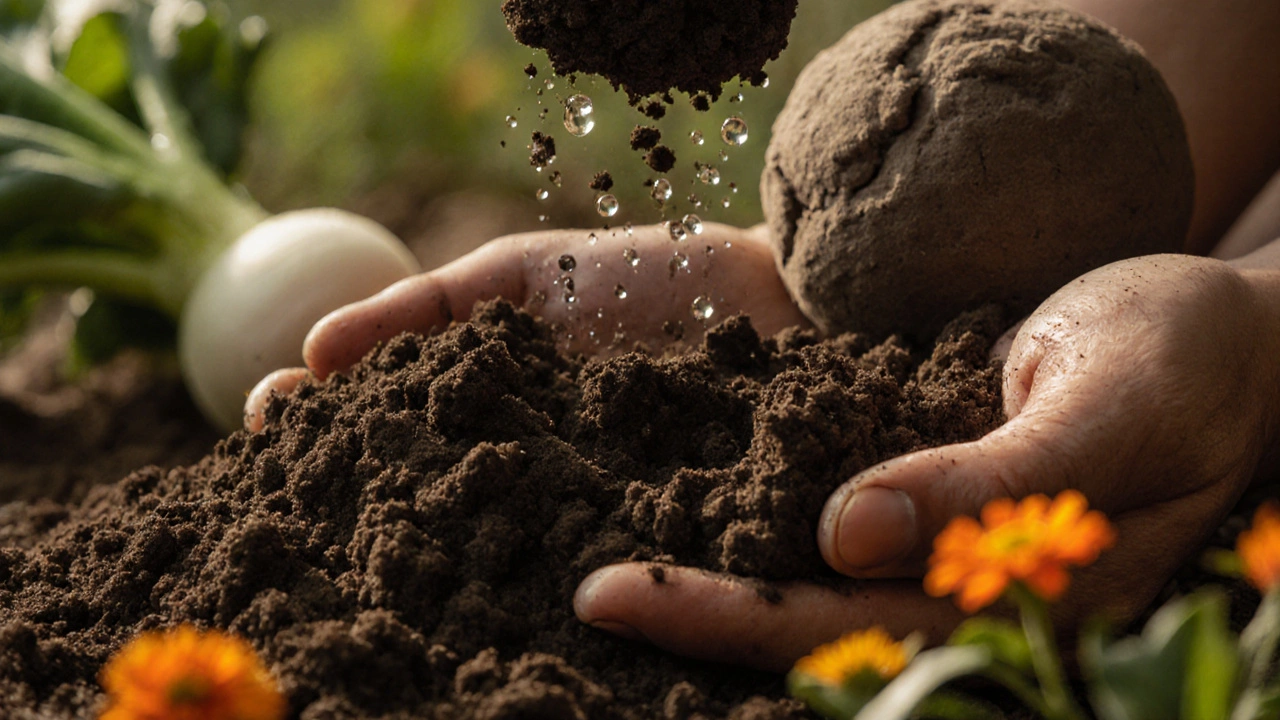
What to Plant While You Wait
You don’t have to wait for perfect soil to start gardening. Some plants actually help fix it.
- Daikon radish - its long taproot punches through hard layers and leaves behind channels for air and water.
- Clover - a cover crop that adds nitrogen and keeps soil from crusting.
- Comfrey - deep roots bring up minerals and die back to feed the soil.
- Marigolds - they repel nematodes and improve soil biology.
Plant these as green manure in empty beds. Cut them down in spring and leave the tops as mulch. You’re not just growing plants - you’re growing better soil.
Testing Your Soil Progress
How do you know if you’re making progress? Here’s a simple test:
- Grab a handful of moist soil.
- Squeeze it gently.
- Open your hand.
If it stays in a hard ball, it’s still too dense.
If it crumbles into chunks, you’re on the right track.
If it falls apart like cookie crumbs, you’ve got loamy soil.
Do this every spring. You’ll see the change.
Final Tip: Think Long-Term
Soil isn’t something you fix once. It’s something you care for. Every time you add compost, leave plant roots in the ground, or mulch with leaves, you’re helping the soil rebuild itself.
Forget quick fixes. Focus on building life in the ground. The more worms, fungi, and bacteria you encourage, the less you’ll need to dig, add, or fix.
Your garden won’t just grow better plants - it’ll grow better soil. And that’s the real win.
Can I use coffee grounds to loosen dense soil?
Coffee grounds are great for adding nitrogen and attracting worms, but they don’t break up clay soil on their own. Used in small amounts - no more than 10% of your compost pile - they help. But if you dump them straight onto dense soil, they can form a slimy mat that blocks water. Mix them into compost first, then use that.
Is gypsum a good solution for clay soil?
Gypsum can help in some cases, but it’s not a magic fix. It works best in soils with high sodium, which is rare in the UK. In most British gardens, gypsum won’t improve structure. It doesn’t add organic matter, and it doesn’t feed microbes. Stick with compost, leaf mold, or perlite instead.
How often should I amend my garden soil?
Add compost or leaf mold every spring. That’s enough for most gardens. If your soil is still dense after two years, mix in perlite or grit sand again. Once your soil feels crumbly and dark, you only need to top-dress - no need to dig it all up again.
Should I remove rocks from my soil before amending it?
Only if they’re large enough to block roots - say, bigger than a golf ball. Small stones are fine. In fact, they help with drainage. Removing them is a waste of time unless you’re laying a lawn or building a raised bed. Let nature keep the small ones.
Can I use worm castings to improve dense soil?
Yes, worm castings are excellent. They’re rich in microbes and help bind soil particles into healthy clumps. Use them as a top dressing or mix a thin layer (about 1 inch) into the topsoil. They’re pricey for large areas, so combine them with cheaper amendments like compost or leaf mold for best results.
